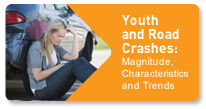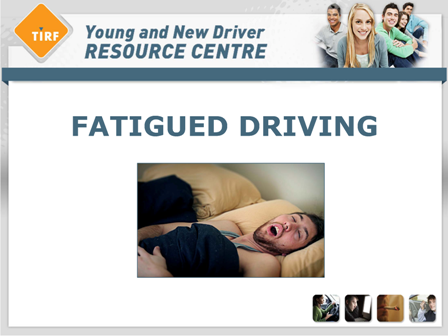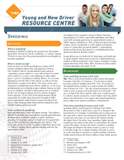The Issues - Fatigue
WHAT IS...What is the difference between fatigued driving and drowsy driving? BEHAVIOURS How does fatigue cause crashes? ATTITUDES, CONCERNS AND PERCEPTIONS What does the public think about fatigued driving? LEGISLATION Are there provincial/territorial fatigued driving laws? SOLUTIONS What needs to be done on our roads and what strategies are available to the public to decrease fatigued driving? WHAT IS...What is the difference between fatigued driving and drowsy driving?
The results of fatigue and drowsiness are the same and can be considered together. The driver is less alert and less attentive and can fall asleep. Both of these conditions reduce the ability to drive.4 Given that the consequences of fatigue and drowsiness on driving are the same, both terms are often used interchangeably. How common is fatigued driving? Crash data analysis shows that 26.4% of all fatal and injury crashes in Ontario (excluding property damage collisions) are fatigue-related.6 Similar to Canada, in the United States it is believed that up to 20% of serious crashes may be due to fatigue. Estimates place the number of fatigue-related crashes between 79,000 and 103,000 per year with 1,500 fatalities annually in the US. 1 Robertson et al. 2009 BEHAVIOURSHow does fatigue cause crashes? The second is 'overload mode'.9 This is characterized by the driver feeling over-aroused due to mental overload and irritability. This causes the driver to make dangerous errors, such as aggressive driving (e.g., road rage) or multi-tasking while driving. Both of these modes increase the chances of crashing. Who is most at risk to drive while fatigued? Studies show that teens most at risk for fatigued driving are those who are considered ‘overachievers’. These teens work long hours at part-time jobs, are involved in several extra-curricular activities and socialize often. They likely possess a vehicle to commute between their responsibilities and do not give sleep the priority it needs. This lifestyle puts them at risk for extreme fatigue behind the wheel.12 Males of all ages are also more likely to be fatigued while driving compared to female drivers. In a 2010 U.S. study, it was reported that 52% of men reported having ever fallen asleep while driving, compared to 30% of female drivers.13 Other drivers at risk are shift workers, who are more likely to be driving late at night, people with sleeping disorders, and those under the influence of alcohol or medication.14 Why are young drivers more likely to drive fatigued? Night time sleep declines over the teen years and teens are more likely to sleep in on the weekends to make up for their late week nights. Teens also experience a decrease in alertness when awake which begins in mid-puberty. These physical changes paired with the experimentation and limit-testing behaviours that are common to teens16 make them quite vulnerable to driving while fatigued. What are the signs of fatigue?
What are the driving behaviours of a fatigued driver? Although driving for long distances is commonly associated with the chances of falling asleep at the wheel, evidence shows that this is not always the case. In fact, 58.8% of people who admitted to falling asleep behind the wheel in the past 12 months did so after driving for less than an hour. Fewer than that (20.6%) reported falling asleep after 3 hours of driving.21 What are the common characteristics of a fatigued-related crash?
When are fatigue-related crashes most likely to occur? Besides our circadian rhythm, we are also subject to a natural homeostasis which is a biological need to sleep. The longer a person is kept awake, the more pressure that will build up for the need to sleep. This force would be the strongest late at night (12 am- 7 am). For these reasons, fatigue-related crashes are most common around the times we biologically cannot deny our body of sleep.25 7 Moller et al. 2006 ATTITUDES, CONCERNS AND PERCEPTIONSWhat does the public think about fatigued driving? Drivers do not think they are likely to be caught driving while fatigued, nor do they think their chances of crashing are very high. This is especially true for males.27 Respondents ranked getting to their destination on time as more important than taking breaks in order to rest. What do young drivers think of fatigued driving? A focus group conducted in the United States with young drivers found that almost all male participants and all female participants reported driving while extremely sleepy. They reported falling asleep at red lights, being woken up by rumble strips and in some cases forgetting their trip home. Although they acknowledged the danger of fatigued driving, all respondents reported getting behind the wheel regardless of the amount of sleep they had the night before, and none of them were willing to give up driving when they knew they were fatigued.29 Why is a fatigued driver dangerous? As well, fatigue has similar effects to alcohol intoxication. Studies show that a person who has not gotten proper rest in over 17 hours is equivalent to a person with a blood alcohol concentration (BAC) of 0.05, which would result in a roadside suspension from police. Sleep deprivation for a full day results in a BAC of 0.10, which is legally drunk.31 How does alcohol interact with fatigue? A study in the United Kingdom found that low levels of sleep combined with low levels of alcohol (under the legal limit) worsened lane drifting in young male drivers (an error that is a common cause of sleep-related crashes). These low levels of alcohol increased the driving impairment already present due to lack of sleep – something that is not realized by drivers.33 The following figure shows how alcohol can affect fatigued driving.34 With less sleep, alcohol has been shown to be associated with many more “off-road deviations” indicating that alcohol does compound the effects of fatigue.
26 Vanlaar et al. 2007 LEGISLATION Are there provincial/territorial fatigued driving laws?
How are fatigued drivers dealt with by the police?
35 Robertson 2009 SOLUTIONS What needs to be done on our roads and what strategies are available to the public to decrease fatigued driving? Highways can be modified in order to better prevent fatigued driving. For instance, rumble strips at both the centre and shoulder line have been found to reduce crash rates by 18-25%. Highway maintenance can make sure to clear away roadside obstacles and provide secure rest areas to encourage breaks.37 If fatigued driving is put at the center of public concern, drivers can begin to learn how dangerous fatigue driving can actually be (comparable to drinking and driving). The message of personal responsibility of the driver should be stressed and drivers should be educated on the strategies available to deal with fatigued driving, such as getting adequate sleep before a road trip and scheduling break times for the journey.38 Why isn’t there more data available on fatigued driving? What should a young driver do to prevent fatigued driving? Researchers suggest that the best strategy to deal with fatigue is to prevent it. Getting enough sleep before any long trip (and ideally, any driving in general) or a nap before driving will decrease the likelihood of crashing due to fatigue. Young drivers have a much higher risk of crashing at night than during the daytime, which is why graduated driver licensing programs developed night time restrictions. These restrictions have led to a 60% decrease in night time crashes of young drivers.42 Passengers can prevent fatigued driving by asking the driver if they are tired. If they are, the passenger should discourage them from driving. What should a driver do if they begin to feel fatigued while driving? The only effective method for dealing with fatigue while driving is to prevent it. Drivers should take breaks at least every 2-3 hours so that fatigue does not become an issue. If this is not possible, and fatigue has already occurred, drinking caffeine and taking a nap have been found to temporarily help drivers deal with drowsiness.44 A study found that both actions relieve fatigue, but only for a few hours.45 Regardless of the ability to hold off sleepiness for a few extra hours with naps or caffeine, a driver should always plan to have the proper amount of rest before a trip and plan ahead for adequate break periods, because once a driver is fatigued, the impairment cannot be reversed.
Beirness, D.J., Simpson, H.M., Desmond, K. (2004). The Road Safety Monitor 2004: Drowsy Driving. Traffic Injury Research Foundation. Ottawa, Canada. Bohan, J.S. (2006). Coffee or Nap? Journal Watch Emergency Medicine. Massachusetts Medical Society. Cansfield, D. (February 2008). Closing Remarks from Ontario’s Minister of Transportation. Working Together to Understand Driver Fatigue: Report on Symposium Proceedings. Highway Safety Roundtable. Toronto, Canada. Carskadon, M.A. (1989/1990). Adolescent Sleepiness: Increased Risk in a High-Risk Population. Alcohol, Drugs and Driving. 5(4)/6(1): 317-328. Elzohairy, Y. (2007) Fatal and Injury Fatigue-Related Crashes on Ontario’s Roads: A 5-Year Review. Highway Safety Roundtable & Fatigue Impairment, Driver Fatigue Symposium, Toronto, May 16th 2007. European Conference of Ministers of Transport (ECMT). (2006). Young Drivers: The Road to Safety. Organisation for Economic Co-operation and Development. Paris, France. Fernandes, R., Soames Job, R.F., Hatfield, J. (2007) A challenge to the assumed generalizability of prediction and countermeasure for risky driving: Different factors predict different risky driving behaviours. Journal of Safety Research. 38(1): 59-70. Fernandes, R., Hatfield, J., Job Soames, R.F. (2010). A systematic investigation of the differential predictors for speeding, drink-driving, driving while fatigued, and not wearing a seat-belt among Young Drivers. Transportation Research Part F. 13(3): 179-196. Horne, J.A., Reyner, L.A. (2003). Driving impairment due to sleepiness is exacerbated by low alcohol intake. Occupational and Environmental Medicine. 60(9): 689-705. Marcoux, K. Vanlaar, W. Robertson, R. (2012). The Road Safety Monitor 2011. Fatigued Driving. Traffic Injury Research Foundation. Ottawa, Canada. Moller, M.J., Kayumov, L., Bulmash, E.L., Nhan, J., Shapiro, C.M. (2006). Simulator Performance, microsleep episodes, and subjective sleepiness: normative data using convergent methodologies to assess driver drowsiness. Journal of Psychosomatic Research. 61(3): 335-342. National Highway Traffic Safety Administration (NHTSA). (March 2006a). Drowsy Driving and Automobile Crashes. NCSDR/NHTSA Expert Panel on Drive and Fatigue and Sleepiness. National Highway Traffic Safety Administration. (September 2006b). Teen Unsafe Driving Behaviours: Focus Group Final Report. DOT HS 810 670. U.S Department of Transportation. Washington, DC. Robertson, R., Holmes, E., Vanlaar, W. (2009). The Facts About Fatigued Driving in Ontario: A guidebook for police. Traffic Injury Research Foundation. Ottawa, Canada. Roehrs, T., Beare, D., Zorick, F., Roth, T. (1994). Sleepiness and Ethanol Effects on Simulated Driving. Alcoholism, Clinical and Experimental Research: 18(1): 154-158. Smiley, A. (February 2008). Strategies for Reducing Fatigue Related Crashes. Working Together to Understand Driver Fatigue: Report on Symposium Proceedings. Highway Safety Roundtable. Toronto, Canada. Stutts, J.C., Wilkins, J.W., Vaughn, B.V. (1999). Why Do People Have Drowsy Driving Crashes? Input From Drivers Who Just Did. Washington DC: AAA Foundation for Traffic Safety. Tefft, B. C. (2010). Asleep at the Wheel: The Prevalence and Impact of Drowsy Driving. Washington, D.C.: American Automobile Association Foundation for Traffic Safety. Wan den Berg, J., Landstrom, U. (2006). Symptoms of Sleepiness while driving and their relationship to prior sleep, work and individual characteristics. Transportation Research Part F: Traffic Psychology and Behaviour. 9(3): 207-226. Vanlaar, W., Simpson, H., Mayhew, D., Robertson, R. (2007). Fatigued and Drowsy Driving: Attitudes, Concerns and Practices of Ontario Drivers. Traffic Injury Research Foundation. Ottawa, Canada. |
  |




